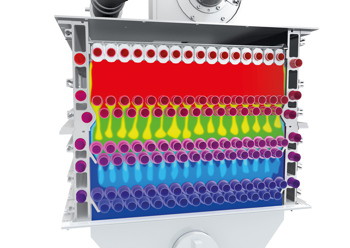The DNA of commercial boilers

Mark Ferris considers the changing demands of floor standing boilers in modern commercial buildings, and outlines the key design considerations for specifiers.
Have the overall developments in technology made all commercial boilers equal – or are there still distinctions between one manufacturer and another?
The answer can often lie ‘under the hood’ of a floor standing commercial boiler, where its building blocks and design concepts are found. In essence, it’s a case of separating out and identifying a boiler’s DNA.
Strand 1: The metal
The first strand that defines a boiler is its metal or, more specifically, the material used in its heat exchanger. Is it aluminium or stainless steel? The industry has been split on the relative benefits of each.
Aluminium offers better heat transfer properties (although it needs to be thicker due to a lower tensile strength). So aluminium offers excellent levels of heat transfer in a new heat exchanger. However, when this is extrapolated over the lifecycle of a boiler, there is cause for concern. An aluminium heat exchanger begins to suffer as soon as it begins operating, due to its porous oxide layer becoming damaged in the presence of moisture and high temperatures. This slow corrosion of the heat exchanger makes it far less efficient over its lifetime and heightens the risk of unit failure.
Stainless steel heat exchangers, on the other hand, are more stable, maintaining a more constant and predictable heat transfer over their entire lifetime. This is thanks to a passive film of chromium oxide, which prevents any corrosive attack, ensuring surfaces remain smooth, bright and clear of deposits.
Strand 2: Efficiency
Critical to the emissions and efficiency of a commercial boiler are its burner technology and heat exchanger design. The size of the burner flame, for example, can contribute to the reduction of NOx emissions, with a smaller flame reducing the time that nitrogen and oxygen have to react. Plus, cooling of the flame, using well thought out heat exchanger design, lowers the flame temperature which in turn also limits NOx production. Furthermore, the geometry of a heat exchanger needs to be optimised to gradually cool down the flue gases to avoid incomplete combustion, therefore achieving very low CO emissions.
By using boilers with the right technology, projects are able to meet the latest legislation, such as NOx class 6, as well as provide BREEAM credits.
Strand 3: Water content

Here lies another industry divide: Are low water content or high water content boilers best for commercial projects? One thing is for sure, commercial heating systems are becoming more complicated, due to the integration of multiple energy sources, such as solar, heat pumps and CHP units, plus the need for efficient heat distribution throughout a building. These demands require correct hydraulic balancing, which is best achieved with a low loss header or buffer. However, a system also demands flexibility and reaction time from its heat source. That’s where water content becomes a crucial consideration.
High water content boilers are bigger, slower to react and inflexible to the demands of a system. Low water content boilers, however, respond rapidly, even in complex installations when combined with other heat sources.
This difference can have a significant impact on costs. Installation time alone can be reduced by up to 50% using a low water content boiler. When it comes to energy consumption comparisons, the difference between low and high water content boilers with similar outputs can run into tens of thousands of pounds over a boiler’s lifetime.
Strand 4: Design
The location of commercial boilers has often been governed by the size and weight of a unit which, for many years, has restricted them to lower level plant rooms with generous access.
However, there is an alternative: modular boilers. These are designed so that even the largest units can be separated into component parts. This offers more flexibility in location, with the ability to use standard stairwells and elevators.
Specifying a commercial floor standing boiler that has a modular design – and a low water content – provides the perfect lightweight combination for rooftop plant rooms, which are becoming an increasingly common.
It is a misconception that all floor standing commercial boilers are the same. For designers and specifiers, looking deeper into a boiler’s DNA can reap dividends in terms of design, installation and long-term operational efficiencies.
Mark Ferris is specification manager at Elco Heating Solutions







